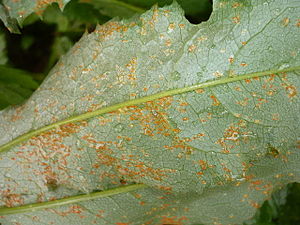Puccinia senecionis
| Puccinia senecionis | ||||||||||||
|---|---|---|---|---|---|---|---|---|---|---|---|---|

Puccinia senecionis on ragwort |
||||||||||||
| Systematics | ||||||||||||
|
||||||||||||
| Scientific name | ||||||||||||
| Puccinia senecionis | ||||||||||||
| Libert |
Puccinia senecionis is a stand fungal art from the order of the rust fungi (Pucciniales). The fungus is an endoparasite of ragweeds . Symptoms of the infestation by the species are rust spots and pustules on the leaf surfaces of the host plants. It is common in large parts of North America and Europe.
features
Macroscopic features
Puccinia senecionis can only be recognized with the naked eye by the spore beds protruding on the surface of the host. They grow in nests that appear as yellowish to brown spots and pustules on the leaf surfaces.
Microscopic features
The mycelium of Puccinia senecionis grows as with all Puccinia TYPES intercellular and forms Saugfäden that grow into the storage tissue of the host. Her spermogonia were not described in detail. The aecia of the species growing on both sides of the host leaves are cup-shaped and cracked at the edge. They have 17–21 × 16–19 µm in size, usually spherical to ellipsoidal and almost hyaline aeciospores with a warty surface. The uredia of the fungus, which grow on both sides, grow scattered. Their uredospores are similar to the aeciospores in shape, size and color. The branches of the species, growing in groups on both sides, are dark chestnut brown, powdery and uncovered. The chestnut-brown teliospores are two-celled, usually ellipsoidal and 23–33 × 16–21 µm in size. Their stem is colorless.
distribution
The known distribution area of Puccinia senecionis extends from North Dakota and Alberta to California and New Mexico . Other countries in which Puccinia senecionis has been detected are Germany, Austria, Switzerland, Romania, Hungary and Japan.
ecology
The host plants of Puccinia senecionis are various ragweeds ( Senecio spp.). In Austria, for example, it occurs on chestnut leafwort and on the Senecio nemorensis aggregate. The fungus feeds on the nutrients present in the storage tissue of the plants, its spore beds later break through the leaf surface and release spores. The species goes through a so-called macrocyclical development cycle with spermogonia, Aecien, Uredien and Telien and does not change host ( autözisch ).
literature
- George Baker Cummins : Rust Fungi on Legumes and Composites in North America . University of Arizona Press, Tucson 1978, ISBN 0-8165-0653-1 .
Individual evidence
- ↑ GBIF Portal ( Memento of the original from November 27, 2015 in the Internet Archive ) Info: The archive link was inserted automatically and has not yet been checked. Please check the original and archive link according to the instructions and then remove this notice. Occurrence research. Retrieved December 11, 2012.
- ↑ Peter Zwetko: The rust mushrooms Austria. Supplement and host-parasite directory to the 2nd edition of the Catalogus Florae Austriae, III. Part, Book 1: Uredinales. P. 44.